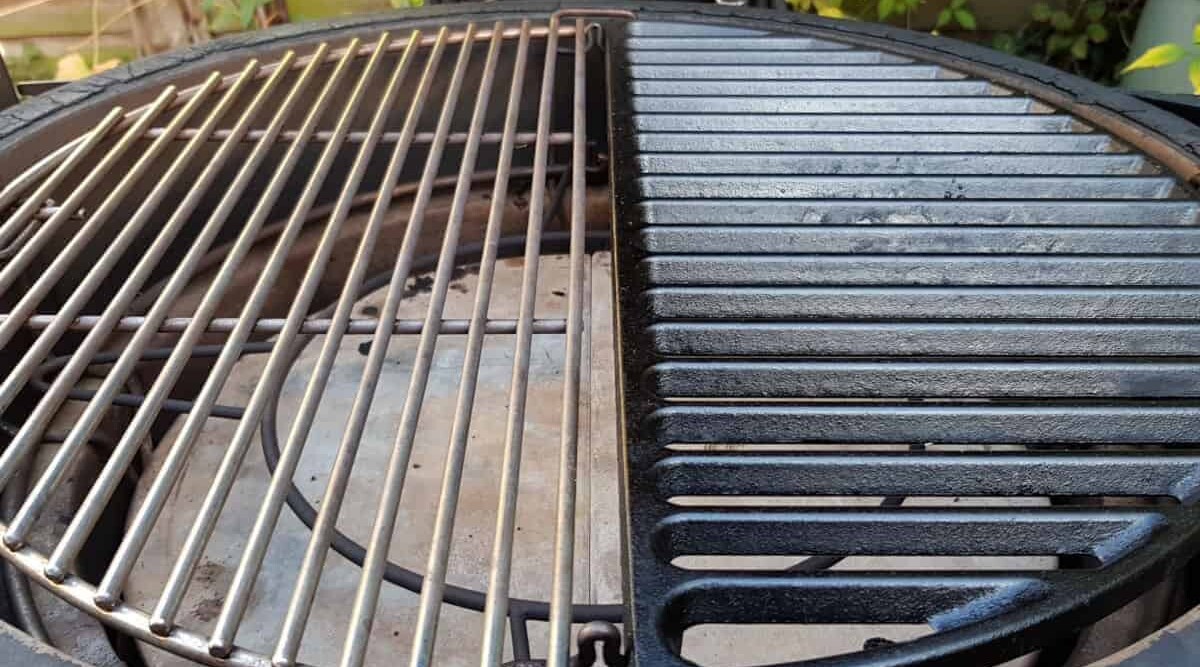
If you’ve ever entertained friends by grilling, you’ve probably received some well-intentioned advice. As you hang out around the grill, people share stories.
Maybe one friend tells you about how the shape of his grill allows it to hold a lot more meat than yours. Maybe another friend tells you what the best material is for your grill grates.
This gets you thinking: In the battle of cast iron vs stainless steel grates, which is better? One friend swears by cast iron. Another raves about stainless steel. You stand there, confused, wondering whether you need to buy a new grill.
Whether you’re purchasing a new grill or just replacing the cooking grate, you will have to decide which material to buy. Learn here what to consider before making your decision.
This article explains the difference between stainless steel grill grates and cast iron, describes how to clean and maintain each properly, and you’ll also learn in which scenario each material is preferable.
Ultimately, you have to make your own decision. However, don’t you want to be armed with knowledge, so you can hold your own when it comes to grill gossip and buying decisions?
Jump to:
- 1 Cast Iron Vs. Stainless Steel 101
- 2 What Are The Pros And Cons Of Cast-Iron Grates?
- 3 What Are The Pros And Cons Of Stainless-Steel Grates?
- 4 Which Should You Buy? Well, What Are You Cooking?
- 5 Cleaning The Different Grates
- 6 How To Prevent Food From Sticking To Your Grates
- 7 What Types Of Grates Can You Buy For Your Grill?
- 8 Conclusion
Cast Iron Vs. Stainless Steel 101
Cast Iron
Cast iron has been used as a cooking surface for thousands of years. However, pure iron is relatively soft. You can cut through it with a knife and some elbow grease.
According to Explain That Stuff, cast iron has carbon added, which makes it extremely hard and durable, but also it can be brittle.
Cast-iron grill grates come in a few different varieties:
- Uncoated cast iron is black and porous and has a slightly rough texture.
- Some cast iron grates may be coated with porcelain enamel. This type has a smooth finish and can be any color.
If a cast-iron grate is not coated with enamel, it remains porous. As it absorbs oils and fats from the foods you cook, it becomes seasoned. The oils fill the pores, giving the cast iron non-stick properties. The material doesn’t contain any added chemicals that can transfer to your foods.
A cast-iron grate with an enamel coating will have better non-stick qualities than uncoated cast iron. However, the coating can crack if you drop the grate.
Over time, scrubbing and scraping enamel-coated grates vigorously can cause them to develop hairline cracks. This won’t happen with uncoated cast iron.
Stainless Steel
First, know that just because it’s silver, doesn’t mean that a grate is made of stainless steel.
Some grates are merely plated regular steel, one of the cheapest kinds of grates. Regular steel and plated versions simply won’t last long when exposed to the heat of your grill and the abuse of tool use and cleaning. Over time the surface can become chipped and nicked, leaving it open to rusting and causing food to stick.
Genuine stainless steel, however, has a smoother surface that is highly resistant to sticking. It also takes far longer to corrode than regular steel and so will last far longer.
However, stainless steel being completely corrosion resistant is a myth. It does corrode and break down with age, though it can last for many, many years.
What Are The Pros And Cons Of Cast-Iron Grates?
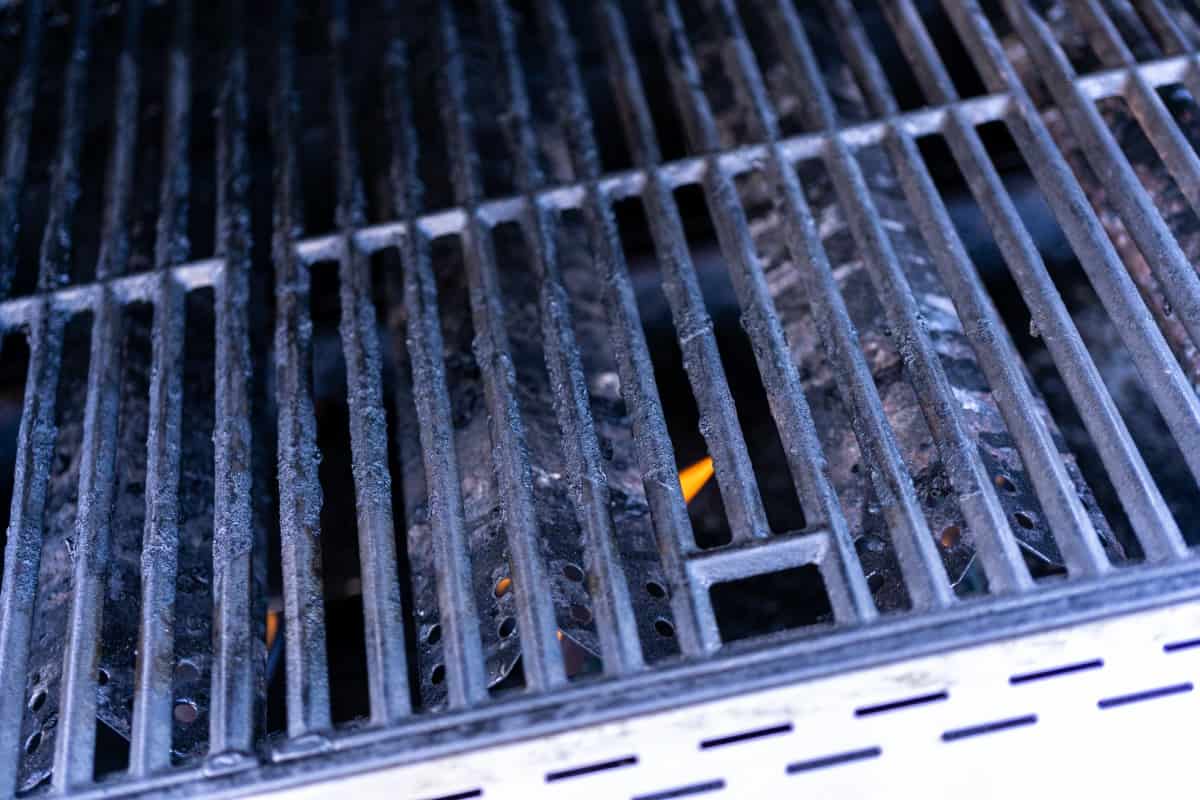
Pros
- Retain heat well — Cooking on cast-iron combines the benefits of stovetop cooking on a cast-iron pan with outdoor grilling. You’ll get a good sear where the grates touch the meat, and you’ll get great heat transfer. This helps you cook your food thoroughly when your charcoal is starting to die down.
- Transfer heat directly — Food that’s touching the surface of the grates will be well-seared. This is ideal for foods that only have to cook for a short amount of time but benefit from a darker outer layer.
- Last for decades — With proper care, your cast-iron grill grates may never have to be replaced.
Cons
- Heavy — Cast-iron grates are extremely heavy. This makes them cumbersome to remove to shift around the charcoal beneath them. You may need a special tool to lift and replace the grate on the grill.
- Rust quickly — An uncoated cast iron grate can rust quickly when exposed to the elements. Even if the grate is inside your grill, it can oxidize in humid weather. If you’re not using it for a while, bring it inside.
- Take more effort to clean — You have to take the extra step of seasoning the grates periodically to maintain the finish.
What Are The Pros And Cons Of Stainless-Steel Grates?
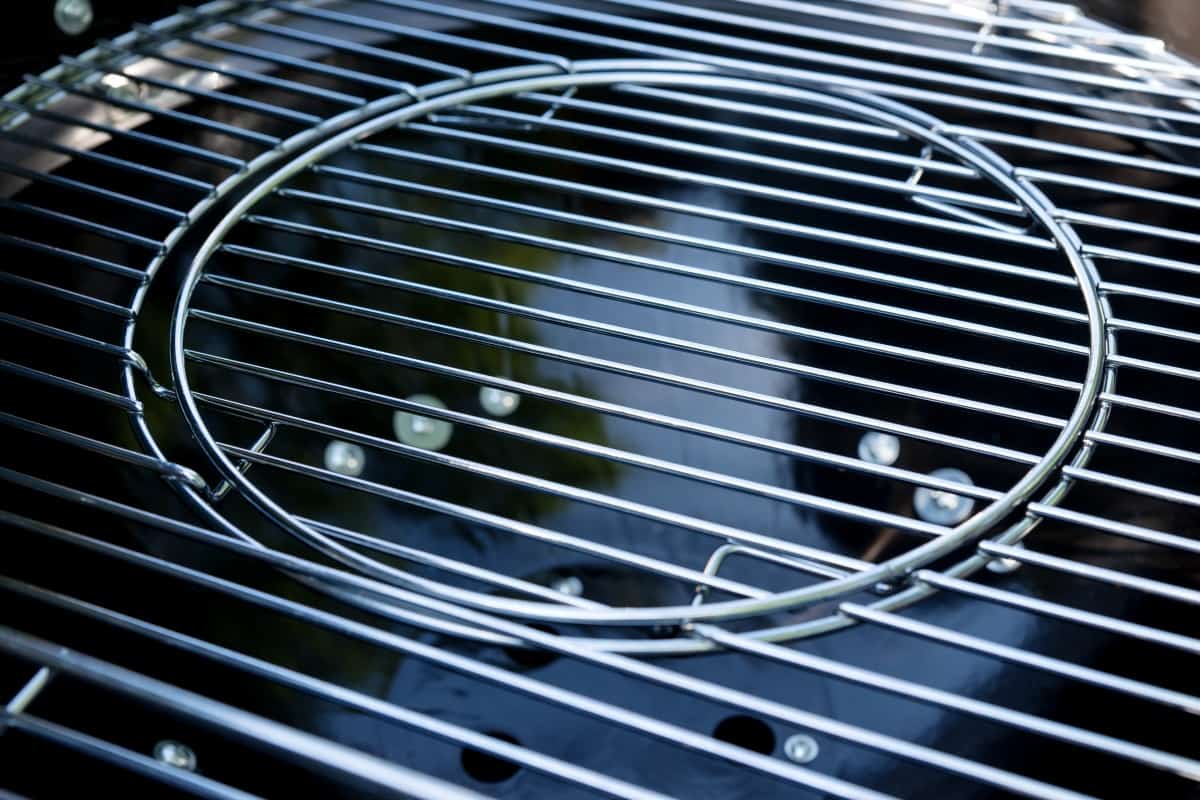
Pros
- Heat up quickly — You don’t have to spend a lot of time preheating your grill before you put on the food.
- Don’t corrode easily — You can leave stainless-steel grates in your grill for longer periods of time than cast iron without worrying about rust.
- Easy to maintain — You don’t have to do anything extra to maintain and clean stainless-steel grill grates.
Cons
- Don’t retain heat well — Stainless steel cools off quickly. It won’t maintain a decent cooking temperature once you’ve removed the heat source.
- Low-quality grates don’t last long — You pay for what you get. Low-priced stainless-steel is usually not as durable.
- Lose their non-stick qualities over time — The more you use the stainless-steel grates, the rougher they get.
- Can droop and warp — Stainless-steel grates can warp over time, providing an uneven grilling surface.
Which Should You Buy? Well, What Are You Cooking?
It may be most important to think about the type of food that you typically cook when buying a new grill grate.
Cast iron heats up more slowly than stainless steel, but once it’s hot, it transfers heat evenly and retains it well. You’ll get well-defined, professional-looking grill marks on your cuts of meat. In other words, you’ll impress your friends.
Are sear marks the gauge by which you should judge a perfect steak? It really depends on your preferences. Some say grill marks aren’t an indicator of perfection.
The part of the grate that touches the meat will cook it directly. That area will turn dark brown or black. This darkening of the meat creates a tasty crust due to the Maillard reaction, so it’s not just looks, it actually improves the taste.
However, thick grates block the radiant heat. Radiant heat can also provide an even, rich crust on a piece of steak.
Thick cuts of meat do well on both cast iron and stainless steel. Chicken is easy to grill on either type of grate.
However, if you’re grilling a thinner, more delicate cut of meat, you might need some direct contact with the cooking surface to give it more flavor. Otherwise, the meat will cook through long before it has time to develop a tasty crust. You’ll have to choose between dry meat with a nice sear or perfectly-cooked meat that’s a little bland on the outside.
Therefore, a thin stainless-steel grate is not the way to go for fish and thin cuts of chicken.
There’s simply not enough direct contact with the meat. Also, your flaky fish might plunge between the grates as you’re trying to flip it.
What if you cook a lot of vegetables and alternative items on the grill?
Pizza does just fine on a stainless-steel grate with narrow bars. So do large pieces of vegetables, like mushroom caps.
But if you’re grilling smaller veggies, however, you might want to go back to a cast-iron grate. The wide, flat bars hold vegetable pieces better without letting them fall through. They also make more contact with the food, creating the caramelization that adds incredible flavor to sometimes bland veggies.
Cleaning The Different Grates
Whether you have stainless-steel or cast-iron grates, you should always clean them immediately after use.
Getting rid of the hot grease and food particles will help them maintain a smooth surface. It will also prevent oil from building up and creating unappetizing smoke that will affect your next meal.
As soon as you have pulled the meat off the grill and the grates are still hot, brush them with a high-quality brush. This will dislodge food from the surface and the heat will help to get rid of much of the residue.
If you haven’t been taking care of your grill as well as you should, deposits can build up on the grates.
Caring for Stainless-Steel Grates
Charbroil.com recommends spreading a piece of aluminum over them while the grill is still hot. This will concentrate the heat on the surface of the grates, burning off residue. Once the grill has cooled a bit, remove the foil and scrub them with a nylon brush.
To deep clean stainless steel grates, remove them from the grill and set them in your kitchen sink.
Sprinkle baking soda all over the grate. Spray or drizzle white vinegar over the baking soda. After it foams up, scrape it with a wire brush. Steel wool will get rid of especially stubborn residue.
Rinse the grate well with water. Allow it to dry before setting it back in your grill.
This video demonstrates the steps for cleaning your stainless-steel grates.
Caring for Your Cast-Iron Grates
According to About.coms barbecues and grilling expert, Derrick Riches, well looked after and regularly cleaned cast iron grates should last for several decades.
After the heat of the grill has burned off the leftover food, scrub the grates with a wire brush. Coat the entire surface of them with an oil that has a high smoke point, and allow it to dry.
If your cast iron grates have rusted or are new, you may need to season them more thoroughly. Remove the grates from the grill and preheat it to 400 or 500 degrees Fahrenheit.
Off the grill, scrub away any rusted areas with steel wool. Place the grates on the preheated grill, and coat them very lightly with oil, literally the thinnest of thin coatings is all that’s needed. Turn off the heat and allow them to cool.
Repeating this process several times will help seal the porous finish.
How To Prevent Food From Sticking To Your Grates
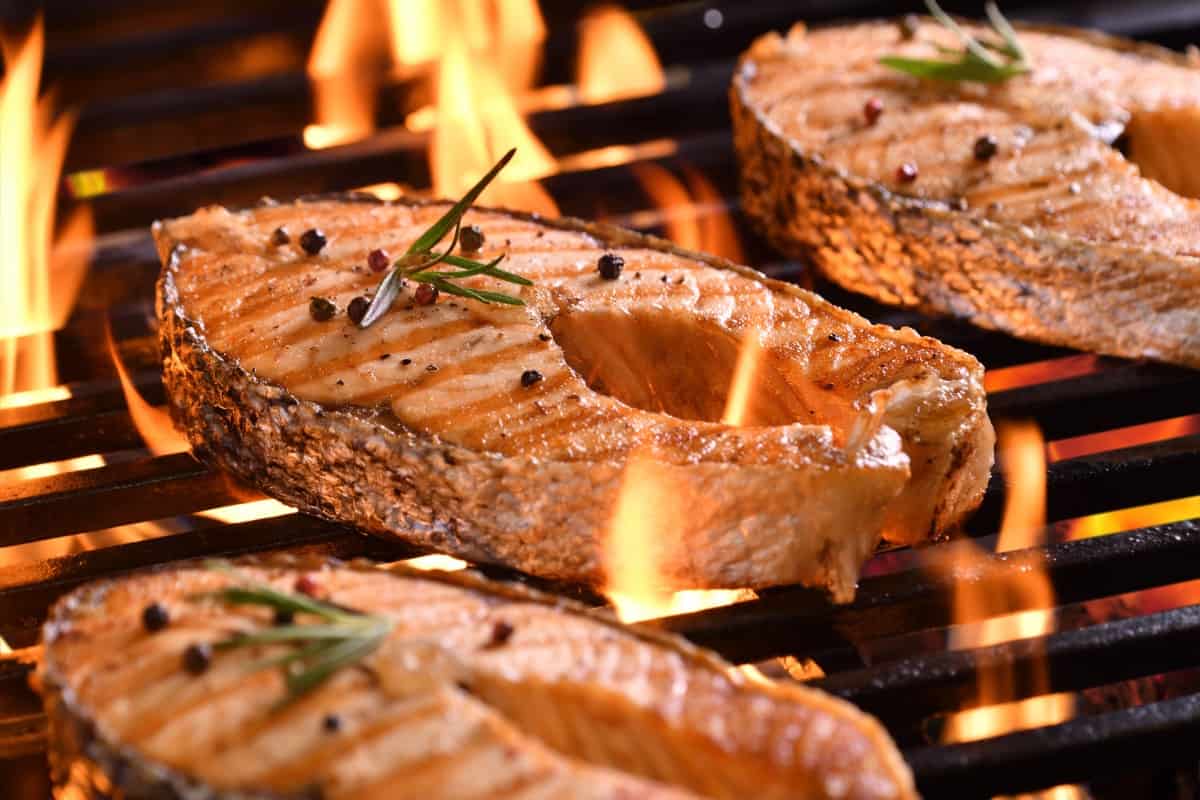
It’s disappointing when the delicious crust that you seared into the food gets stuck on the grates. As you flip your meat, the perfectly browned grill marks disappear and drop into the fire.
Cleaning the grates properly can prevent this from happening. So can the following techniques for preparing and cooking the food.
Don’t Rely On Non-Stick
Experts and marketers often claim that cast iron develops a non-stick surface over time. That’s true for cast-iron pans.
However, cast-iron grates are exposed to much higher temperatures than pans. The oils that fill the nooks and crannies in cast-iron pans and deliver a non-stick surface are more likely to be burned off completely in a grill.
Similarly, even the shiniest metal grates aren’t truly smooth. They have a microscopic texture that can grab on to food.
Oil The Food
Many people suggest oiling the food instead of oiling the grates.
First, pat the food dry with a towel. Then, apply an oil with a high smoke point, like refined olive oil or corn oil.
When the food is placed on the grate, the oil will fill in the pores on the grate and in the food. This creates a slick surface that’s less likely to bond together.
However, even using all the oil in the world won’t prevent some foods from sticking to the grates. Keep reading for more techniques to prevent sticking on cast-iron and stainless-steel surfaces.
Don’t Flip Too Early
The sizzle you hear when food hits the grate is the water from the food steaming off and evaporating.
Once the part of the food touching the grill grates has dried out, the steam will cause it to separate from the oil on the grate. The food will release more easily at that point.
If you go to flip your meat, and it won’t let go of the grate, wait a few more moments. The steam will eventually weaken the bond.
Preheat Your Food
Cold food is more likely to stick to a hot grate than hot food. To prevent a sticky food, like a chicken burger, from latching on to the grate, cook it gently on top of a piece of oiled tin foil spread across the grill. Once the outer layer of the food has warmed up, you can place it directly on the grates.
If you’re concerned about a gummy glaze causing your food to stick, brush the glaze onto the top surface of the food first. After it has heated up and bonded to the food for a few minutes, flip it over so that the glaze is in contact with the grates.
Some food, like fish, is going to stick to the grill no matter what. The shape of the grate bars can affect this.
With a high-quality, thin spatula, you’ll be able to get most of the material off of a wide stainless-steel grate. A cast iron grate with sharp corners might hold on to some of your food regardless of what you do.
What Types Of Grates Can You Buy For Your Grill?
Some brands can be purchased with different grate options. If the grates are made for your grill’s brand, they’ll fit perfectly. If you don’t have the option of selecting the grates that you want, you may need to buy them separately.
Some manufacturers make cast-iron grates that sit on top of the stainless-steel ones that come with a grill. You don’t have to worry as much about your grill size or shape if you buy these.
If you buy the type of grates that sit on top of your existing ones, you have the best of both worlds. You can swap them out depending on what you’re cooking.
Conclusion
One of the worst things you can do is buy low-quality grates. During use, they’re exposed to dramatic temperature changes and a lot of heat and moisture. A cheap grate will warp, lose its non-stick qualities and corrode more easily than a high-quality one.
Cast iron is practically indestructible, but if it’s left outside for too long without proper maintenance, it will rust. It’s possible to reverse the problem and bring corroded cast iron back to its original splendor. It’s just tedious to get into every space if you’ve let your cast iron go.
Stainless steel is more durable when exposed to sun, moisture and heat. If you don’t protect your grill or live in an especially humid area, you might prefer a stainless-steel grate to a cast-iron one.
So in the battle of stainless steel grill grates vs cast iron, which is the winner? Well, there isn’t a clear one. So…
If your friends try to give you advice about the best kind of grill grate, remind them that it’s a personal preference. There’s no clear winner in this battle.
Happy grilling!


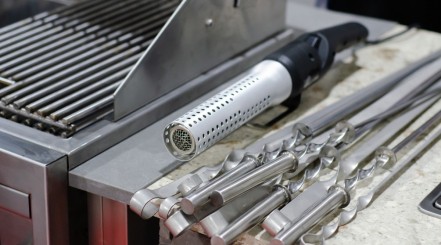
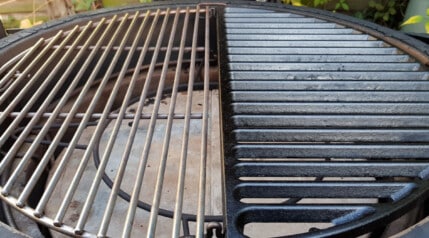
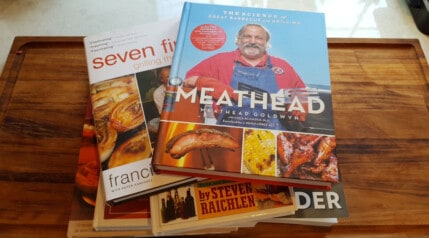
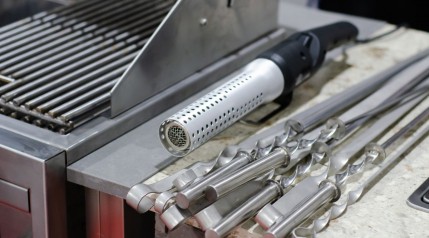
Great tips here for those looking at buying a new grill. Thanks!
Thank you, Bridget…though it’s useful for more than just that if you look around! Lots of great grilling, smoking and BBQ info 😀
Thank you! Most articles cover seat and cleaning, but nothing specific about how the food cooks. You gave me the info I was looking for. I grill fish and veggies often. It’s a pain to clean, but I’ll stick with cast iron.
I’m a big cast iron fan myself. Especially for getting a ‘full face sear’ on my solid half moon grates. For steaks and chops, you can’t beat it!
Super disappointed with my expensive new Kenmore Elite BBQ from Sears. It has stainless steel grates and “thermo shield” technology, which I’m guessing is to prevent dummies from burning their steaks? Anyhow, it won’t put any color or nice crust on anything. Steaks come in cooked eventually (12-13 minutes!) but looking an unappetizing gray color. I recently bought a nice adjustable cast-iron grate at Home Depot, and laid it on top of the stainless existing grates … Back in char-broil heaven! Cast Iron mo bettah fo sho! Haha! Wish I could get my $1300 back, and my trusty falling apart old Weber gas grill! Happy Grilling!
Hey Andrew,
I’m not familiar with the Kenmore ‘Thermo Shield’, but stainless grates are good for grilling, so I’m not sure what’s happening here. My Weber kettles, Kamado Joes and more all have stainless grates and if it’s ‘sear marks’ you’re after, then certainly cast iron is better as they retain heat and focus it more to get the signature grill lines. I prefer to actually go for a ‘full face sear’ myself though, to get more flavor from the Maillard reaction all over the face of the meat, not just where the bars are. I’m going off-topic…
Anyhow…yes, sorry you had a bad experience with the Kenmore, but I’m not sure what the ‘thermo shield’ is. Is it not removable? An optional item to have in while you cook? If you can remove it, all might be well after possibly?
Very informative thank you I’m still making my mind up as to which is the best Though I suppose it’s due to the fact I’m not sure which gas BBQ to buy
I prefer cast iron myself, though tend to have both for most of my grills. A bit overkill maybe, and not everybody can budget for that either.
Going to buy replacement grates for my Weber gas grill. The porcelain grates rusted out. What’s the best option? Better yet, what is your preference? I’m leaning towards coated cast iron.
Thanks
Generally speaking I’m a cast iron man myself. I buy CI grates for all my grills, have a CI Dutch oven, CI skillets. I love the stuff, and if looked after lasts a lifetime.
Mark, Thank you, for a very thoughtful and practical article!! It really helped me understand the pros and cons of both types of grills — and helped me make my decision. Have a great day!
Thank you!
Thank you for helping me figure out what replacement grates to get my husband for his birthday. Appreciate all the details!
Great info. How do you feel about infrared grills?
I like them. I like all types and styles of grill and smoker, it’s an addiction of mine at this point, lol. I don’t actually own one, but have cooked on my friends large gasser that has IR searing and an IR burner for rotisserie. For searing, it’s incredible, the heat is ridiculous. I wouldn’t pick an outright IR grill (with no standard burners) one over a standard grill though, personally. They’re not as versatile and because of that I’m not sure if they’re worth the extra cost. You can find out the pros and cons of IR grills here.
A Great article on Cast Iron Vs Stainless Steel Grates — however, I have a dilemma: it seems that most up-market BBQ manufacturers always provide Stainless Steel grates…e.g. Napoleon, Cal Flame, Lion, Lynx,,, so is this not an indication that Stainless Steel is the best option?
Hi John,
I wouldn’t say either is best, there’s no right or wrong, it’s a matter of preference and depends on what you want to cook, and how. I tried to explain all above, so people can make their own decisions on it. Both stainless and CI have their pros and cons, and different people may want either and for different purposes.
I would say ‘high-end grills’ tend to have a high grade of stainless grate (instead of cast iron) because they are going to last longer, are easier to maintain, and yes they do cost more. But as explained above, cast iron can have some benefits over stainless grates, so it depends on the individuals wants and needs which they prefer and why.
Some good info. Been using cast iron and stainless for years. I am always open to another opinion. Not crazy about porcelain, it is nice but not durable enough in my opinion. I love cooking on cast iron pans as long as me or my wife take care of them after the cooking. That’s very important. I need to replace the grates on my grill, so I will choose cast iron. Your article on this is very informative. Thanks, bill.
We just moved into a condo which is right on the beach over the Pacific Ocean. The article makes a good argument for the cast iron grates, but I know that rust will be an issue. The grill I have settled on comes with cast iron, but I think my best option is to pay for stainless replacement grates right away. The good thing is that the grill has a searing zone to get a good char on my steaks.
Yes, cast iron does need some upkeep, even if away from salty air. It’s totally fine, so long as you do the necessary cleaning, seasoning, and so on. But if you dare to skimp on it, the grates will suffer. Stainless steel is way more convenient, with less upkeep required.
Thanks, Mark – very helpful and well-written article on cast iron vs. stainless steel grilling grates. My questions have been answered and I feel empowered to make an informed purchase….thanks for your expertise and attention to what readers want/need to know. Happy grilling!
Never tried cast iron grates. I assume they are very similar to cast iron frying pans which we do use on a regular basis.
For those of you who ever left a well seasoned cast iron pan in the stove too long you’ll know that the high heat burns off ALL of the carbon coating. Years of buildup removed in 10-15 minutes. A high power grill (that easily gets over 500 degrees) will continuously burn off the seasoning from the grates, thus losing its nonstick properties and also making it vulnerable to rust if not retreated (oiled) after every cook. Most people won’t do that and will be forced to reseason a couple times a year. Steele is WAY more convenient than cast iron, but cast iron cooks way better. If you move your grill inside after it cools down and live in a low humid area cast iron is a no brainer. If you live in florida type humidity cast iron may not be a great choice for us lazy people.
I have a Weber Genesis grill. It cooks great but in 10 years I have been through 3 sets of cast iron grates. Customer service says oil coating them is what makes the top layer come off. We are finishing a meal where the sear mark of our port chops had cast iron metal in them. The cast iron grate in my Big Green Egg is original, the same age, and sits next to my Weber.
Hi Stretch,
Although the Weber grates are cast-iron, they are porcelain-enameled so don’t need seasoning, merely kept clean. I’ve only had my Genesis (and also a Spirit) for a bout 3 years now, and their grates are still fine. They don’t get too much use though, as I prefer to cook over charcoal mostly.
you should never clean staniless steel with a carbon steel brush or steel wool. these can embed carbon steel in the stainless which will lead to rust. either use a scotch brite pad or a stainless brush.
Im so confused! This was helpful though. Im
Looking at the ones available in our area and have a choice between Beefeater which gives cast iron grates and Bull which gives stainless steel. We live a very hot climate with a lot of direct sun coming down in our space.